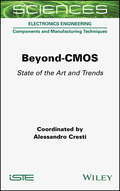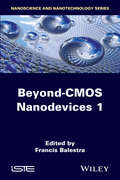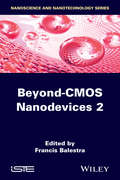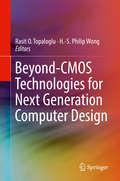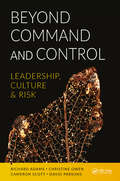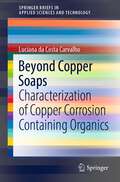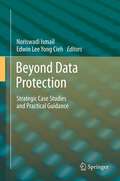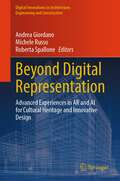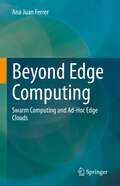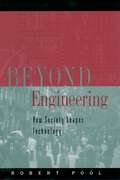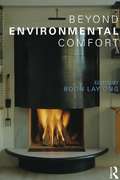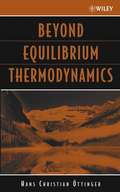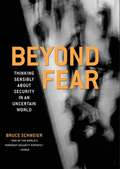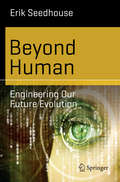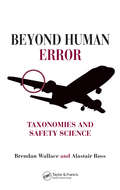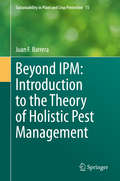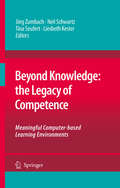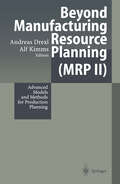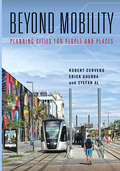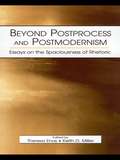- Table View
- List View
Beyond-CMOS: State of the Art and Trends
by Alessandro CrestiRecent advances in physics, material sciences and technology have allowed the rise of new paradigms with bright prospects for digital electronics, going beyond the reach of Moore's law, which details the scaling limit of electronic devices in terms of size and power. This book presents original and innovative topics in the field of beyond CMOS electronics, ranging from steep slope devices and molecular electronics to spintronics, valleytronics, superconductivity and optical chips. Written by globally recognized leading research experts, each chapter of this book will provide an introductory overview of their topic and illustrate the state of the art and future challenges. Aimed not only at students and those new to this field, but also at well-experienced researchers, Beyond-CMOS provides extremely clear and exciting perspectives about the technology of tomorrow, and is thus an effective tool for understanding and developing new ideas, materials and architectures.
Beyond-CMOS: State of the Art and Trends
by Alessandro CrestiRecent advances in physics, material sciences and technology have allowed the rise of new paradigms with bright prospects for digital electronics, going beyond the reach of Moore's law, which details the scaling limit of electronic devices in terms of size and power. This book presents original and innovative topics in the field of beyond CMOS electronics, ranging from steep slope devices and molecular electronics to spintronics, valleytronics, superconductivity and optical chips. Written by globally recognized leading research experts, each chapter of this book will provide an introductory overview of their topic and illustrate the state of the art and future challenges. Aimed not only at students and those new to this field, but also at well-experienced researchers, Beyond-CMOS provides extremely clear and exciting perspectives about the technology of tomorrow, and is thus an effective tool for understanding and developing new ideas, materials and architectures.
Beyond-CMOS Nanodevices 1
by Francis BalestraThis book offers a comprehensive review of the state-of-the-art in innovative Beyond-CMOS nanodevices for developing novel functionalities, logic and memories dedicated to researchers, engineers and students. It particularly focuses on the interest of nanostructures and nanodevices (nanowires, small slope switches, 2D layers, nanostructured materials, etc.) for advanced More than Moore (RF-nanosensors-energy harvesters, on-chip electronic cooling, etc.) and Beyond-CMOS logic and memories applications.
Beyond-CMOS Nanodevices 1
by Francis BalestraThis book offers a comprehensive review of the state-of-the-art in innovative Beyond-CMOS nanodevices for developing novel functionalities, logic and memories dedicated to researchers, engineers and students. It particularly focuses on the interest of nanostructures and nanodevices (nanowires, small slope switches, 2D layers, nanostructured materials, etc.) for advanced More than Moore (RF-nanosensors-energy harvesters, on-chip electronic cooling, etc.) and Beyond-CMOS logic and memories applications.
Beyond-CMOS Nanodevices 2
by Francis BalestraThis book offers a comprehensive review of the state-of-the-art in innovative Beyond-CMOS nanodevices for developing novel functionalities, logic and memories dedicated to researchers, engineers and students. The book will particularly focus on the interest of nanostructures and nanodevices (nanowires, small slope switches, 2D layers, nanostructured materials, etc.) for advanced More than Moore (RF-nanosensors-energy harvesters, on-chip electronic cooling, etc.) and Beyond-CMOS logic and memories applications.
Beyond-CMOS Nanodevices 2
by Francis BalestraThis book offers a comprehensive review of the state-of-the-art in innovative Beyond-CMOS nanodevices for developing novel functionalities, logic and memories dedicated to researchers, engineers and students. The book will particularly focus on the interest of nanostructures and nanodevices (nanowires, small slope switches, 2D layers, nanostructured materials, etc.) for advanced More than Moore (RF-nanosensors-energy harvesters, on-chip electronic cooling, etc.) and Beyond-CMOS logic and memories applications.
Beyond-CMOS Technologies for Next Generation Computer Design
by Rasit O. Topaloglu H.-S. Philip WongThis book describes the bottleneck faced soon by designers of traditional CMOS devices, due to device scaling, power and energy consumption, and variability limitations. This book aims at bridging the gap between device technology and architecture/system design. Readers will learn about challenges and opportunities presented by “beyond-CMOS devices” and gain insight into how these might be leveraged to build energy-efficient electronic systems.
Beyond Command and Control: Leadership, Culture and Risk
by Richard Adams Christine Owen Cameron Scott David Phillip ParsonsThis book will advance the understanding of leadership beyond the inherited myths and modalities of command and control. Leadership is separated from ideas and institutional seniority and explained as the collaborative power of one with others. Enabling the intelligent co-participation of all people, the constructive effect of this approach to leadership is in the engagement of people. This is significant when task accomplishment depends not on managerial direction, but on the interaction of people with each other, with technical systems, and with complex regulations which are often across jurisdictional boundaries. Examples and case studies are included.
Beyond Command and Control: Leadership, Culture and Risk
by Richard Adams Christine Owen Cameron Scott David Phillip ParsonsThis book will advance the understanding of leadership beyond the inherited myths and modalities of command and control. Leadership is separated from ideas and institutional seniority and explained as the collaborative power of one with others. Enabling the intelligent co-participation of all people, the constructive effect of this approach to leadership is in the engagement of people. This is significant when task accomplishment depends not on managerial direction, but on the interaction of people with each other, with technical systems, and with complex regulations which are often across jurisdictional boundaries. Examples and case studies are included.
Beyond Copper Soaps: Characterization of Copper Corrosion Containing Organics (SpringerBriefs in Applied Sciences and Technology)
by Luciana da CarvalhoThis book reports a series of electrochemical experiments where copper was corroded in the presence of various organic substances. Combining data from spectroscopy techniques, X-ray diffraction and mass spectrometry (including proteomics) the experiments demonstrate that copper-organic complexes can be formed during the corrosion of copper. The low solubility of copper-organic complexes in organic solvents and their amorphous nature mean that these compounds cannot be easily detected by one single analytical technique. This book benefits researchers investigating the presence of organic residues in archaeological copper corrosion and copper-organic complexes in art, where sampling is often subject to curatorial constraints.
Beyond Data Protection: Strategic Case Studies and Practical Guidance
by Noriswadi Ismail and Edwin Lee Yong CiehThe book deals with data protection issues from practical viewpoints. 40% of the content focus on the Malaysian Personal Data Protection Act (PDPA) 2010 progress, whilst 60% of the content focus on leading comparative practical guidance from Europe. Part of the PDPA provisions is mirrored from European approaches and practices. The approach of this book is straightforward, handy and readable and is supplemented by practical applications, illustrations, tables and diagrams. Practical examples highlighted in this book range from cloud computing, radio frequency identification technology, social media networks and information security to basic related aspects of data protection issues covering strategic leadership, management, governance and audit in businesses, organisations and local authorities. Recommended best practices have been outlined for practical guidance accompanied with future challenges and opportunities for Malaysia and ASEAN. The book is equally suitable for academics, practitioners, governmental officials and regulators dealing with data protection within their sector-specific legislation.
Beyond Digital Representation: Advanced Experiences in AR and AI for Cultural Heritage and Innovative Design (Digital Innovations in Architecture, Engineering and Construction)
by Andrea Giordano Michele Russo Roberta SpalloneThis book collects contributions which showcase the impact of new augmented reality (AR) and artificial intelligence (AI) technologies considered jointly in the fields of cultural heritage and innovative design. AR is an alternative path of analysis and communication if applied to several fields of research, in particular if related to space and artifacts in it. This happens because the neural network development strengthens the relationship between augmented reality and artificial intelligence, creating processes close to human thought in shorter times. In the last years, the AR/AI expansion and the future scenarios have raised a deep trans-disciplinary speculation. The disciplines of representation (drawing, surveying, visual communication), as a convergence place of multidisciplinary theoretical and applicative studies related to architecture, city, environment, tangible and intangible cultural heritage, are called to contribute to the international debate. The book chapters deal with augmented reality and artificial intelligence, analyzing their connections as research tools for knowing the environment. In particular, the topics focus on the intersection between real and virtual world and on the heuristic role of drawing in the enhancement and management of cultural heritage, in planning and monitoring the architecture, the environment, or the infrastructures. Scientists involved in AR and AI research applied separately or together in the field of cultural heritage, architectural design, urban planning, and infrastructures analysis, as well as members of public and private organizations make up interdisciplinary groups that fuel the discussion focusing on the priorities and aims of the research related to the disciplines of representation.
Beyond Edge Computing: Swarm Computing and Ad-Hoc Edge Clouds
by Ana Juan FerrerThis book explores the most recent Edge and Distributed Cloud computing research and industrial advances, settling the basis for Advanced Swarm Computing developments. It features the Swarm computing concepts and realizes it as an Ad-hoc Edge Cloud architecture.Unlike current techniques in Edge and Cloud computing that solely view IoT connected devices as sources of data, Swarm computing aims at using the compute capabilities of IoT connected devices in coordination with current Edge and Cloud computing innovations. In addition to being more widely available, IoT-connected devices are also quickly becoming more sophisticated in terms of their ability to carry considerable compute and storage resources. Swarm computing and Ad-hoc Edge Cloud take full advantage of this trend to create on-demand, autonomic and decentralized self-managed computing infrastructures.Focusing on cognitive resource and service management, the book examines the specific research challenges of the Swarm computing approach, related to the characteristics of IoT connected devices that form the infrastructure. It also offers academics and practitioners insights for future research in the fields of Edge and Swarm computing.
Beyond Engineering: How Society Shapes Technology (Sloan Technology)
by Robert PoolWe have long recognized technology as a driving force behind much historical and cultural change. The invention of the printing press initiated the Reformation. The development of the compass ushered in the Age of Exploration and the discovery of the New World. The cotton gin created the conditions that led to the Civil War. Now, in Beyond Engineering, science writer Robert Pool turns the question around to examine how society shapes technology. Drawing on such disparate fields as history, economics, risk analysis, management science, sociology, and psychology, Pool illuminates the complex, often fascinating interplay between machines and society, in a book that will revolutionize how we think about technology. We tend to think that reason guides technological development, that engineering expertise alone determines the final form an invention takes. But if you look closely enough at the history of any invention, says Pool, you will find that factors unrelated to engineering seem to have an almost equal impact. In his wide-ranging volume, he traces developments in nuclear energy, automobiles, light bulbs, commercial electricity, and personal computers, to reveal that the ultimate shape of a technology often has as much to do with outside and unforeseen forces. For instance, Pool explores the reasons why steam-powered cars lost out to internal combustion engines. He shows that the Stanley Steamer was in many ways superior to the Model T--it set a land speed record in 1906 of more than 127 miles per hour, it had no transmission (and no transmission headaches), and it was simpler (one Stanley engine had only twenty-two moving parts) and quieter than a gas engine--but the steamers were killed off by factors that had little or nothing to do with their engineering merits, including the Stanley twins' lack of business acumen and an outbreak of hoof-and-mouth disease. Pool illuminates other aspects of technology as well. He traces how seemingly minor decisions made early along the path of development can have profound consequences further down the road, and perhaps most important, he argues that with the increasing complexity of our technological advances--from nuclear reactors to genetic engineering--the number of things that can go wrong multiplies, making it increasingly difficult to engineer risk out of the equation. Citing such catastrophes as Bhopal, Three Mile Island, the Exxon Valdez, the Challenger, and Chernobyl, he argues that is it time to rethink our approach to technology. The days are gone when machines were solely a product of larger-than-life inventors and hard-working engineers. Increasingly, technology will be a joint effort, with its design shaped not only by engineers and executives but also psychologists, political scientists, management theorists, risk specialists, regulators and courts, and the general public. Whether discussing bovine growth hormone, molten-salt reactors, or baboon-to-human transplants, Beyond Engineering is an engaging look at modern technology and an illuminating account of how technology and the modern world shape each other.
Beyond Environmental Comfort
by Boon Lay OngBeyond Environmental Comfort highlights some of the key ideas that form the foundation of the field of environmental comfort and, at the same time, gives voice to some of the concerns and considerations on the limitations of the field as it stands today. Bringing together a range of foremost thinkers in their respective fields - Michel Cabanac, Derek Clements-Croome, Nick Baker, Harold Marshall, Juhani Pallasmaa, Dean Hawkes, and Constance Classen - this book argues for a deeper appreciation of how environmental comfort may be understood in terms of our relationship with the environment rather than as independent qualities. For the first time these diverse views are brought together by Editor Boon Lay Ong to present insights into a world beyond what is normally covered in academic research. In the process, an attempt is made to define the field for the future. This book shows that it is by understanding just how environmental design needs to go beyond mere comfort and deal with well-being that we can meaningfully design our future.
Beyond Environmental Comfort
by Boon Lay OngBeyond Environmental Comfort highlights some of the key ideas that form the foundation of the field of environmental comfort and, at the same time, gives voice to some of the concerns and considerations on the limitations of the field as it stands today. Bringing together a range of foremost thinkers in their respective fields - Michel Cabanac, Derek Clements-Croome, Nick Baker, Harold Marshall, Juhani Pallasmaa, Dean Hawkes, and Constance Classen - this book argues for a deeper appreciation of how environmental comfort may be understood in terms of our relationship with the environment rather than as independent qualities. For the first time these diverse views are brought together by Editor Boon Lay Ong to present insights into a world beyond what is normally covered in academic research. In the process, an attempt is made to define the field for the future. This book shows that it is by understanding just how environmental design needs to go beyond mere comfort and deal with well-being that we can meaningfully design our future.
Beyond Equilibrium Thermodynamics
by Hans Christian ÖttingerBeyond Equilibrium Thermodynamics fills a niche in the market by providing a comprehensive introduction to a new, emerging topic in the field. The importance of non-equilibrium thermodynamics is addressed in order to fully understand how a system works, whether it is in a biological system like the brain or a system that develops plastic. In order to fully grasp the subject, the book clearly explains the physical concepts and mathematics involved, as well as presenting problems and solutions; over 200 exercises and answers are included. Engineers, scientists, and applied mathematicians can all use the book to address their problems in modelling, calculating, and understanding dynamic responses of materials.
Beyond Fear: Thinking Sensibly About Security in an Uncertain World
by Bruce SchneierMany of us, especially since 9/11, have become personally concerned about issues of security, and this is no surprise. Security is near the top of government and corporate agendas around the globe. Security-related stories appear on the front page everyday. How well though, do any of us truly understand what achieving real security involves?In Beyond Fear, Bruce Schneier invites us to take a critical look at not just the threats to our security, but the ways in which we're encouraged to think about security by law enforcement agencies, businesses of all shapes and sizes, and our national governments and militaries. Schneier believes we all can and should be better security consumers, and that the trade-offs we make in the name of security - in terms of cash outlays, taxes, inconvenience, and diminished freedoms - should be part of an ongoing negotiation in our personal, professional, and civic lives, and the subject of an open and informed national discussion.With a well-deserved reputation for original and sometimes iconoclastic thought, Schneier has a lot to say that is provocative, counter-intuitive, and just plain good sense. He explains in detail, for example, why we need to design security systems that don't just work well, but fail well, and why secrecy on the part of government often undermines security. He also believes, for instance, that national ID cards are an exceptionally bad idea: technically unsound, and even destructive of security. And, contrary to a lot of current nay-sayers, he thinks online shopping is fundamentally safe, and that many of the new airline security measure (though by no means all) are actually quite effective. A skeptic of much that's promised by highly touted technologies like biometrics, Schneier is also a refreshingly positive, problem-solving force in the often self-dramatizing and fear-mongering world of security pundits.Schneier helps the reader to understand the issues at stake, and how to best come to one's own conclusions, including the vast infrastructure we already have in place, and the vaster systems--some useful, others useless or worse--that we're being asked to submit to and pay for.Bruce Schneier is the author of seven books, including Applied Cryptography (which Wired called "the one book the National Security Agency wanted never to be published") and Secrets and Lies (described in Fortune as "startlingly lively...¦[a] jewel box of little surprises you can actually use."). He is also Founder and Chief Technology Officer of Counterpane Internet Security, Inc., and publishes Crypto-Gram, one of the most widely read newsletters in the field of online security.
Beyond Human: Engineering Our Future Evolution (Science and Fiction)
by Erik SeedhouseBeyond Human is an informative and accessible guide for all those interested in the developing sciences of genetic engineering, bio printing and human cloning. Illustrating the ideas with reference to well-known science fiction films and novels, the author provides a unique insight into and understanding of how genetic manipulation, cloning, and other novel bio-technologies will one day allow us to redesign our species. It also addresses the legitimate concerns about “playing God”, while at the same time embracing the positive aspects of the scientific trajectory that will lead to our transhuman future.
Beyond Human Error: Taxonomies and Safety Science
by Brendan Wallace Alastair RossA ground-breaking new book, Beyond Human Error: Taxonomies and Safety Science deconstructs the conventional concept ofhuman error and provides a whole new way of looking at accidents and how they might be prevented. Based on research carried out in the rail, nuclear, and defense industries, the authors show how, by concentrating solely on
Beyond IPM: Introduction to the Theory of Holistic Pest Management (Sustainability in Plant and Crop Protection #15)
by Juan F. BarreraAbout 15 years ago, we asked ourselves why the methods developed by the research institutions for the management of pests were almost not used by small landholder farmers. It seemed obvious to us that conventional pest control –called “Integrated Pest Management”– was based on a reductionist approach. In reviewing the literature on the subject, we found that our concern was not new or unique. The agreement of some authors with our ideas reinforced our efforts to find a holistic approach to pest management. We took two central ideas to develop the holistic approach: First, pest management actions must put the farmer at the center of the system. Second, pest management must consider not only both pests but the other important components of the system in question. This approach based on the farmers and the systems in which they are immersed, is called “Holistic Pest Management” or HPM. In this book, I present the philosophy and practice of HPM, a new paradigm of pest management.
Beyond Knowledge: Meaningful Computer-based Learning Environments
by Jörg Zumbach Liesbeth Kester Neil Schwartz Tina SeufertThe edited and peer reviewed volume presents selected papers of the conference “Beyond knowlegde: the legacy of competence” organized by EARLI SIG Learning and Instruction with Computers in cooperation with SIG Instructional Design. It reflects the current state-of-the-art work of scholars worldwide within the area of learning and instruction with computers. Mainly, areas of computer-based learning environments supporting competence-focused knowledge acquisition but also foundational scientific work are addressed. More specific, contents cover cognitive processes in hypermedia and multimedia learning, social issues in computer-supported collaborative learning, motivation and emotion in Blended Learning and e-Learning.
Beyond Manufacturing Resource Planning (MRP II): Advanced Models and Methods for Production Planning
by Andreas Drexl Alf KimmsThe logic of Manufacturing Resource Planning (MRP II) is im plemented in most commercial production planning software tools and is commonly accepted by practitioners. However, these peo ple are not satisfied with production planning and complain about long lead times, high work-in-process, and backlogging. As many researchers have pointed out, the reason for these shortcomings is inherent to the methods that are used. The research community is thus eager to find more sophisticated approaches. This book is an attempt to compile some state-of-the-art work in the field of production planning research. It includes mate rial that somehow dominates the existing MRP II concept. 15 ar ticles written by 36 authors from 10 countries cover many aspects related to MRP II. All papers went through a single-blind refere eing process before they were selected for being published in this book. When we received papers for this issue, we discovered that MRP II is a topic about which not only management scientists show interest. As the list of authors proves, industrial engineers, computer scientists, and-operations researchers from academia as well as practitioners have contributed to this book. This, we hope, makes the book of value for a broad audience. We thank all authors who submitted papers. And, we are in debted to Dr. Werner Muller from Springer for his support in this book project.
Beyond Mobility: Planning Cities for People and Places
by Robert Cervero Erick Guerra Stefan AlThis volume is about prioritizing the needs and aspirations of people and the creation of great places. This is as important, if not more important, than expediting movement. A stronger focus on accessibility and place creates better communities, environments, and economies. Rethinking how projects are planned and designed in cities and suburbs needs to occur at multiple geographic scales, from micro-designs (such as parklets), corridors (such as road-diets), and city-regions (such as an urban growth boundary). It can involve both software (a shift in policy) and hardware (a physical transformation). Moving beyond mobility must also be socially inclusive, a significant challenge in light of the price increases that typically result from creating higher quality urban spaces.
Beyond Postprocess and Postmodernism: Essays on the Spaciousness of Rhetoric
by Theresa Enos Keith D. MillerIn this collection of original essays, editors Theresa Enos and Keith D. Miller join their contributors--a veritable "who's who" in composition scholarship--in seeking to illuminate and complicate many of the tensions present in the field of rhetoric and composition. The contributions included here emphasize key issues in past and present work, setting the stage for future thought and study. The book also honors the late Jim Corder, a major figure in the development of the rhetoric and composition discipline. In the spirit of Corder's unfinished work, the contributors to this volume absorb, probe, stretch, redefine, and interrogate classical, modern, and postmodern rhetorics--and challenge their limitations. Beyond Postprocess and Postmodernism: Essays on the Spaciousness of Rhetoric will be of interest to scholars, teachers, and students in rhetoric and composition, English, and communication studies. Offering a provocative discussion of postprocess composition theories and pedagogies and postmodern rhetorics, as well as the first thorough consideration of Jim Corder's contributions, this work is certain to influence the course of future study and research.
